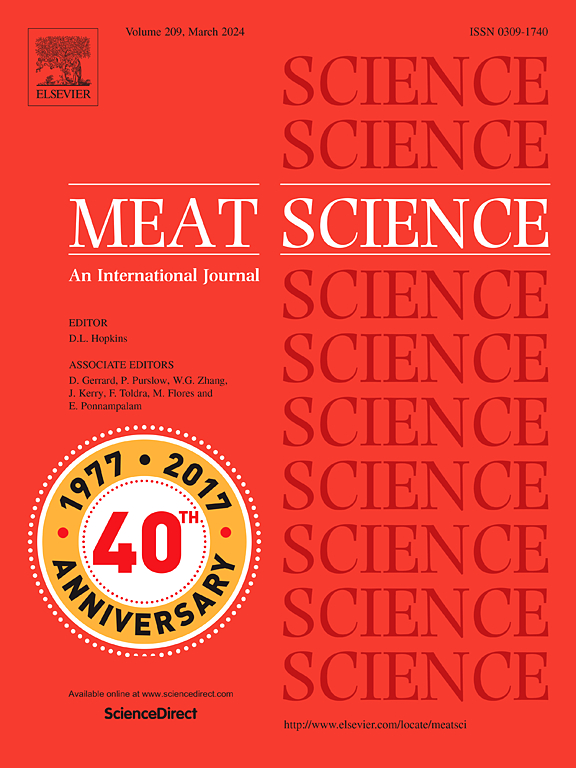副干酪乳杆菌B1和植物乳杆菌O24超声无细胞上清液对熟猪肉香肠品质决定因素的影响
IF 6.1
1区 农林科学
Q1 Agricultural and Biological Sciences
引用次数: 0
摘要
本研究的目的是评估从副干酪乳杆菌B1和植物乳杆菌O24培养物中获得的冻干无细胞上清(CFS)对熟猪肉香肠在4°C下保存21天的特性的影响。评估了以下参数:抗氧化活性(ABTS,还原力,铁螯合活性),质地参数(硬度,弹性,粘性,咀嚼性)和颜色变化(L*,a*,b*),以及脂肪酸谱和TBARS含量作为脂质氧化的指标。还评估了微生物状况。结果表明,冻干CFS的使用对香肠的pH值、氧化状态和质地有显著影响。与植物乳杆菌O24变体相比,添加副乳杆菌B1 CFS的产品具有较低的硬度、粘性和耐嚼性。菌株类型和CFS处理方法均未引起煮熟猪肉香肠颜色的变化。在贮藏过程中,贮藏第7天TBARS指数升高,表明脂质氧化过程加剧,特别是在副干酪乳杆菌B1的CFS产品中。所有香肠都保持了适当的微生物质量。考虑到超声波作为获得CFS阶段的附加程序的影响,超声波处理的香肠样品(B1_S和O24_S)具有较高的抗氧化活性,但同时更容易受到脂质氧化过程的影响。本文章由计算机程序翻译,如有差异,请以英文原文为准。
The effect of sonicated cell-free supernatant from Lacticaseibacillus paracasei B1 and Lactiplantibacillus plantarum O24 on selected quality determinants of cooked pork sausages
The aim of the study was to assess the effect of lyophilized cell-free supernatant (CFS) obtained from Lacticaseibacillus paracasei B1 and Lactiplantibacillus plantarum O24 cultures on the characteristics of cooked pork sausages stored by 21 days at 4 °C. The following parameters were assessed: antioxidant activity (ABTS, Reducing Power, Fe-chelating activity), texture parameters (hardness, springiness, gumminess, chewiness) and color changes (L*,a*,b*), as well as the fatty acid profile and TBARS content as an indicator of lipid oxidation. Microbiological status was also assessed. The results showed that the use of lyophilized CFS had a significant effect on the pH, oxidation status and texture properties of sausages. Products with the addition of CFS from L. paracasei B1 were characterized by lower hardness, gumminess and chewiness compared to variants with L. plantarum O24. Neither the strain type nor the method of CFS treatment caused changes in the color of cooked pork sausages. During storage time, an increase in the TBARS index was also observed on the 7th day of storage, which indicates an intensification of lipid oxidation processes, especially in products with CFS obtained from L. paracasei B1. All sausages retained the appropriate microbiological quality. Considering the effect of sonication as an additional procedure at the stage of obtaining CFS, the sausage samples to which it was applied (B1_S and O24_S) showed higher antioxidant activity, but at the same time were more susceptible to lipid oxidation processes.
求助全文
通过发布文献求助,成功后即可免费获取论文全文。
去求助
来源期刊

Meat Science
工程技术-食品科技
CiteScore
12.60
自引率
9.90%
发文量
282
审稿时长
60 days
期刊介绍:
The aim of Meat Science is to serve as a suitable platform for the dissemination of interdisciplinary and international knowledge on all factors influencing the properties of meat. While the journal primarily focuses on the flesh of mammals, contributions related to poultry will be considered if they enhance the overall understanding of the relationship between muscle nature and meat quality post mortem. Additionally, papers on large birds (e.g., emus, ostriches) as well as wild-captured mammals and crocodiles will be welcomed.
 求助内容:
求助内容: 应助结果提醒方式:
应助结果提醒方式:


